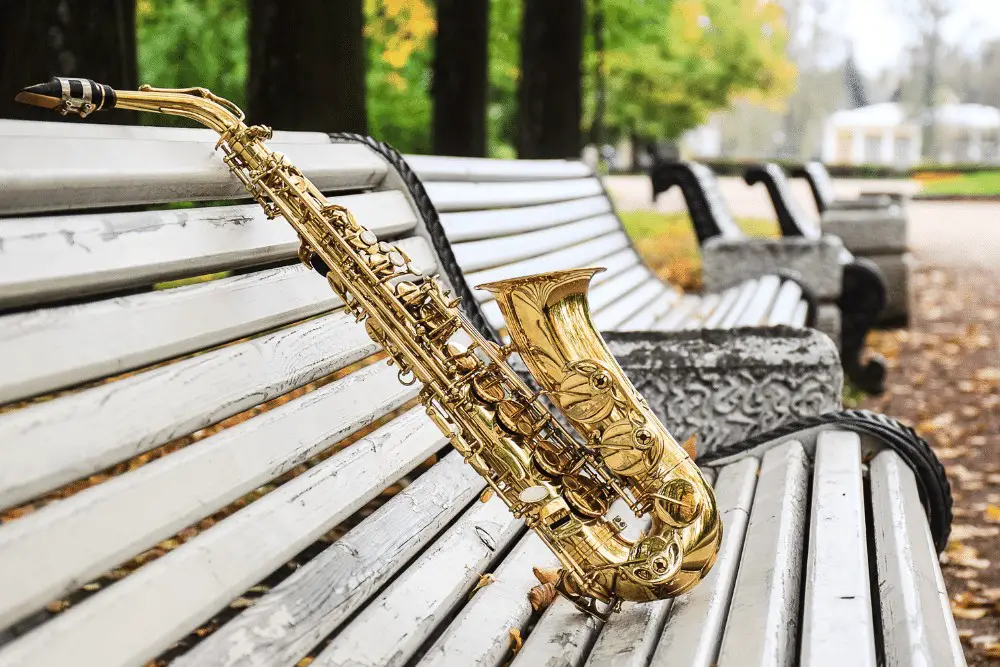Every single year around this time, my fifth graders are looking at which instrument to play if they want to join a band. With every musical instrument they look at, they wonder if it’ll be too hard.
Since the saxophone is one of the more popular instruments, I’m asked about this all the time.
In general, the saxophone isn’t a hard instrument to learn, especially at the beginning. The embouchure (lip shape) stays the same across all notes; the notes are changed simply by pressing and releasing keys, and creating a good sound is achievable early on.
The saxophone is a great starter woodwind instrument, but it does have some challenges. Take a look at the rest of the article for more info to help you decide if this woodwind instrument is for you.
Table of Contents
Why Is The Saxophone Easy To Learn?
Let’s start by looking at what makes the saxophone such a good starter instrument.
Note: All of these assume we’re talking about the alto saxophone, which is the common one most people start on.
Many of these features also apply to the larger tenor saxophone and baritone saxophone, but it takes more finger work and air to play those.
Embouchure/Mouth Shape
All instruments have to produce sound through vibration, and some of these ways are tough. The embouchure or mouth shape of a brass instrument like the trumpet is tight and changes with each note.
Check out our saxophone vs. trumpet detailed comparison.
Some like the flute have to angle an airstream at the exact right spot to split the air, causing vibrations. If it sounds tricky, it’s because it is.
The saxophone player will simply need to put their lips on the mouthpiece and blow. Yes, it’s more involved in this, but once you’ve got it (and it’ll come pretty quick), it stays the same for pretty much every note in your range.
At this point, all you need to do is learn the combination of keys to press for each note.
Sound Production
Along the same lines, the barrier to producing sound is low on the saxophone. It’ll take some practice to get it down, and when you reach higher levels of play, you’ll want to experiment with the mouth shape to get the perfect tone.
For those starting out, it won’t take much work to get it to sound. This is different than the other instrument families (except percussion) and the flute, which takes a lot more work to make sound good at an early stage.
I’ve seen it time and again in middle school bands. In the first two years, the saxophones are the rock stars because the instrument design helps them progress quickly at first.
Then, other instruments start to catch up as they master their sound production technique.
Changing Notes
For learning notes, it doesn’t get much easier than the saxophone. Yes, the saxophone has a bunch of keys (around 20 depending on the design and quality of the sax), but here’s the thing:
When you change the combination of keys, it’ll basically automatically change the notes for you.
You don’t have to worry about altering your mouth shape or remembering which notes belong with which combination. It’s straightforward, and when you want to jump up to higher notes, you press the octave key and use the same fingerings as the lower notes.
The flute has a similar fingering strategy as does the clarinet.
But the clarinet is much tougher because the fingerings only work for half the instrument. When you change registers, you have to relearn the fingerings all over again.
You may think I’m full of it to say the sax is easy to finger when compared to other instruments in the brass family. After all, the trumpet and french horn only have 3 valves compared to 20 keys.
Well, consider this:
When a brass player does a fingering, such as 1-2, they have to remember which of potentially 8 notes they could play and target this note with their lips too!
Sure, you have fewer combinations, but you also have more to think about with each one of those. With the sax, you only need to know one set of fingerings for each note.

What Makes The Saxophone Hard To Learn?
It’s not all sunshine and roses, though, folks. There are some more challenging aspects to this wind instrument than some others.
Advanced Techniques
Because the sax is a newer instrument (only invented in the 1840s), it is full of music using advanced techniques and the modern genre.
The beginner and average sax player won’t get to these, but if you’re even a little serious about the sax, you’ll need to pick these techniques up.
You won’t get there until you’ve put in hours of practice over a long period of time, but when you do, it’s tough.
Most other instruments have a ton of classical music and orchestral music with challenging but traditional techniques to pull from.
The saxes do not. You’ll run into these tricks and more advanced music theory earlier on than the rest of them.
Again, this isn’t really what happens with young musicians, but adults need to accept this will happen to them too when they reach a higher level.
Stretched Fingers
For the youngest students, I don’t recommend the saxophone.
I’m talking about students under fifth grade in age.
While younger may be able to understand and play the sax, it’s tougher for them because the saxophone weighs more and requires your fingers to stretch out more.
With larger members of the saxophone family, such as the bari sax, I’d hold off on learning it until high school.
Luckily, the fingerings and technique all transfer from each type of saxophone.
Saxophone Care
Saxophone players also need to be extra careful about the care of their instrument, more than most of the other wind instruments.
A combination of the brass material, higher air pressure, and the edges of the tone holes make the saxes a big collector of grime, debris, moisture, and potential bacteria.
There’s even a thing called “saxophone lung” where people may inhale the bacteria, causing a pneumonia-like infection.
It’s all easily avoided with daily care for cleaning the saxophone.
Most other instruments can get away with weekly cleanings, but the sax needs to be wiped out every time you play to prevent buildup.
For some, this is a big inconvenience.
Who Should Or Shouldn’t Play The Saxophone?
All this being said, I do have some general recommendations for who will be the most successful on the sax and who may not. Keep these in mind to see if it helps you decide if the sax is right for you.
| Who should play the alto sax? | Who shouldn’t play the alto sax? |
|---|---|
| Anyone who likes the sound of the sax. | People younger than fifth grade or with very small hands. |
| People who really love jazz and modern types of music. | Those who don’t like the sound of the saxophone. |
| Someone looking for a low barrier to entry. | People who don’t like jazz. |
| People who already have a saxophone on hand. | Those who don’t like to do daily, quick maintenance and cleaning. |
| Anyone older than fifth grade. | Someone who already has another instrument. |
FAQ
How long does it take to learn the saxophone? – While it depends on the level of skill you want to reach, the general belief is that it takes 10,000 hours to master an instrument.
Is saxophone harder than guitar? – In most ways, no. But it does have different types of challenges when you reach the advanced level of practice.
Can I teach myself the sax? – A private saxophone lesson teacher and joining a band is always the best way, but I’ve known some people have great success in learning with online programs.
I’d check out Alto Saxophone Lessons For Beginners on Udemy. It’s the best one for learning the sax from the start.
Which saxophone is best for the beginner? – The best sax for beginners is the Yamaha YAS 280.
Check out our top 5 picks of the best saxes for beginners.
How many hours a day should I practice the sax? – While it depends on what level you are and what level you’re trying to reach, I’d recommend practicing 30-60 minutes for five to six days per week.

